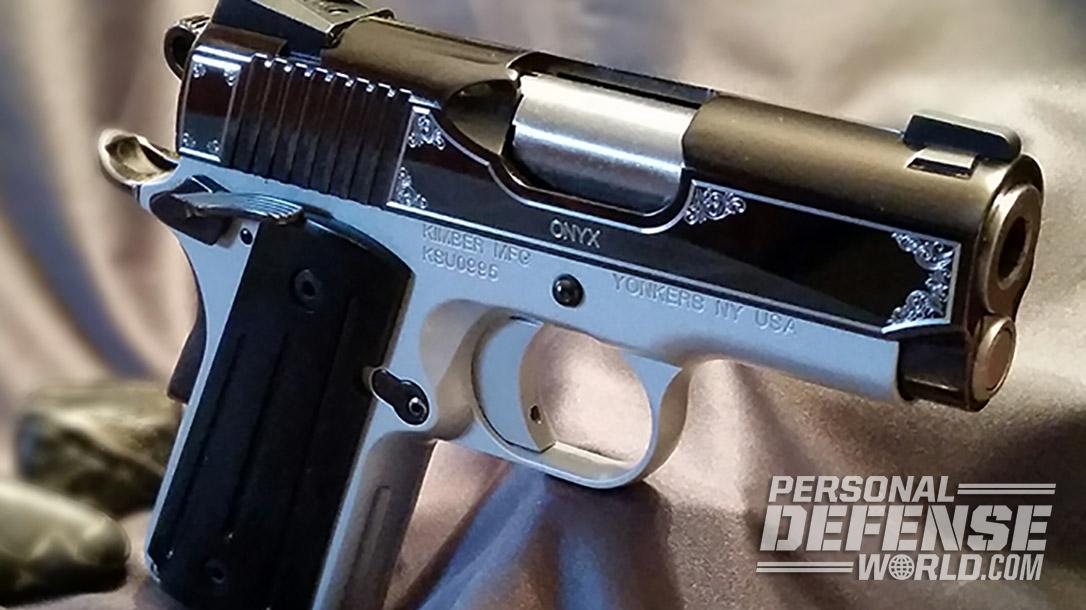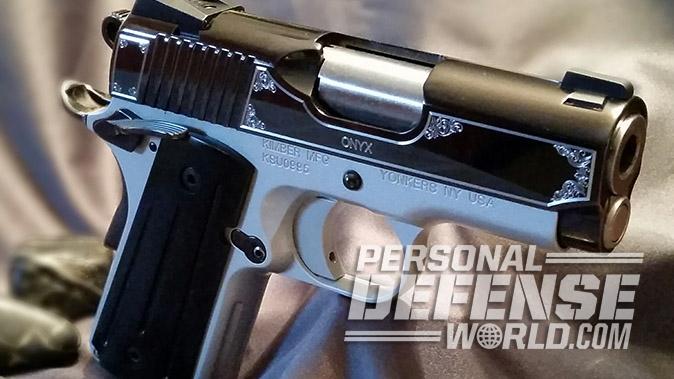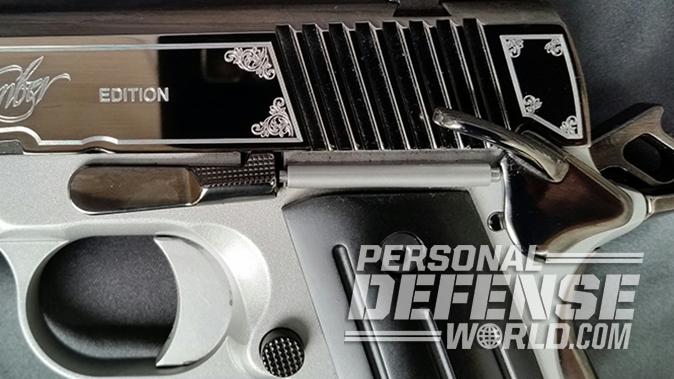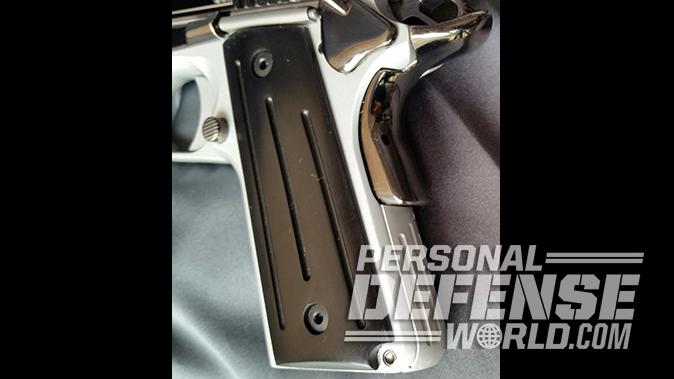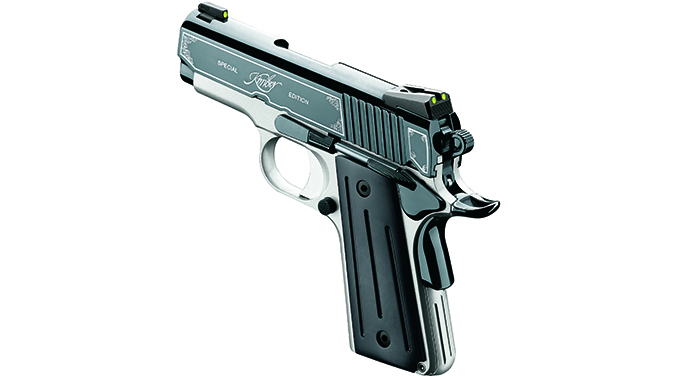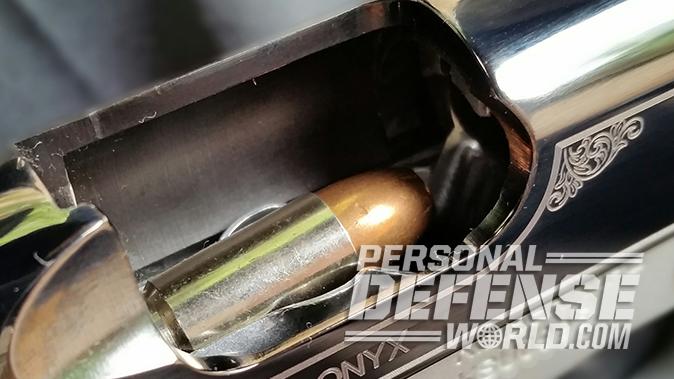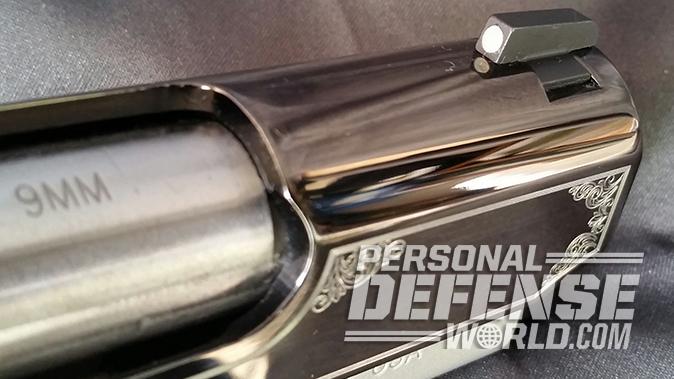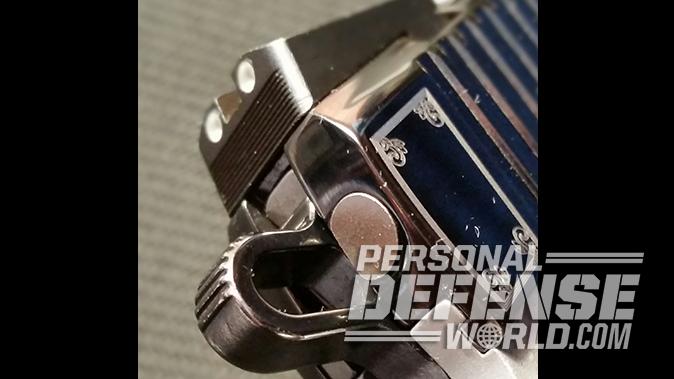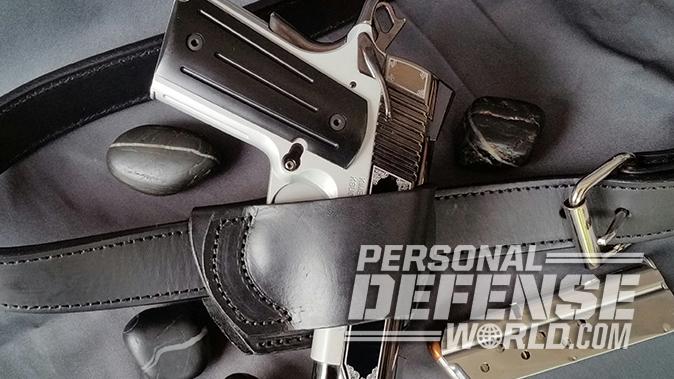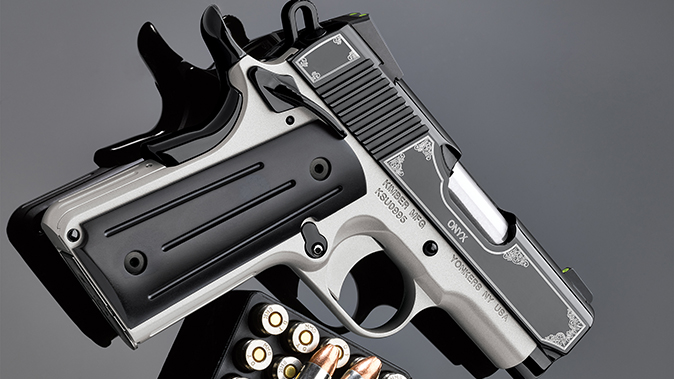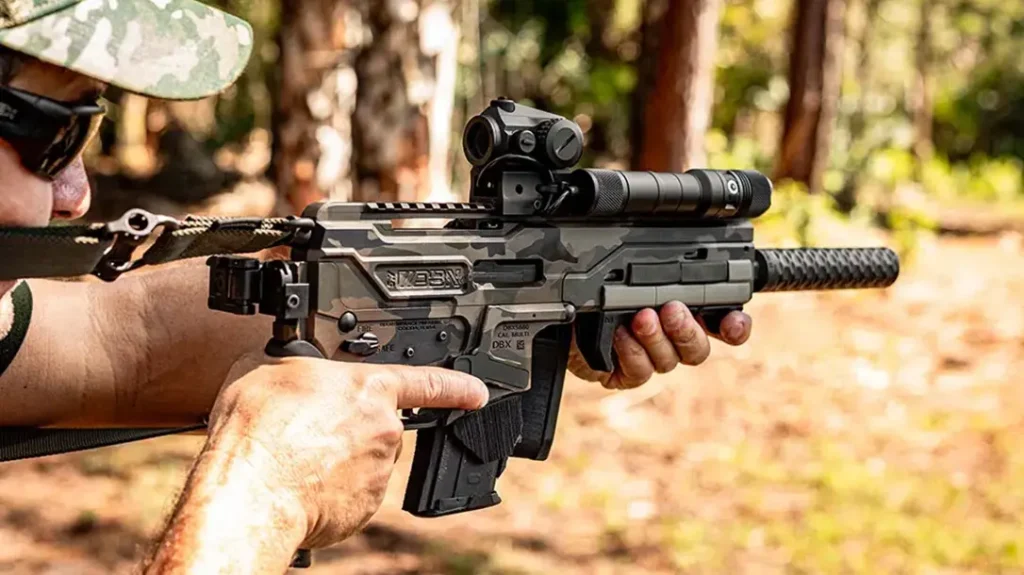Kimber presented its Ultra II line of mini 1911 pistols nearly two years ago, and these handy little guns—6.8 inches long overall, 25 ounces in weight, and chambered in 9mm or .45 ACP with 3-inch barrels—have quickly caught on with those seeking highly concealable single-action autoloaders. A special “dressed-up” version was unveiled to the shooting public earlier this year called the Kimber Onyx Ultra II.
The moniker is appropriate, as an onyx is normally a black gemstone with white bands. The slide on the Kimber Onyx Ultra II pistol has a shiny, deep black PVD coating over polished stainless steel with cut scroll engraving. It’s truly a gemstone of a pistol. Smaller parts like the grip safety, ambidextrous thumb safety, slide release and magazine catch are also coated in black PVD. The aluminum alloy frame wears a satin silver finish, and the thin, ball-milled Micarta grips are black in color.
Advertisement — Continue Reading Below
Gem Of A Nine
I tested a 9mm Kimber Onyx Ultra II that arrived in a black plastic carrying case lined with foam rubber and included a safety lock, a takedown tool and a detailed owner’s manual.
The pistol’s fixed sights are dovetailed into the slide, and both the front blade and Tactical Wedge rear sight are fitted with tritium inserts for enhanced low-light shooting. The 3-inch, stainless steel, match-grade barrel has a 1-in-16-inch twist rate and is precisely fitted to the slide, so no separate barrel bushing is used. An integral lug at the breech end of the barrel incorporates the feed ramp and holds the barrel link. Beneath the barrel, the concentric recoil spring, with a full-length guide rod, is held in place by a recoil plug at the muzzle. The firing pin is inactive until the grip safety is fully depressed.
The grip safety itself is an extended beavertail design to protect the web of the hand from the oval-shaped, Commander-style hammer. Below that, the mainspring housing is flat but rounded at the heel to help with concealability. The mainspring housing and frontstrap are ball milled for a more secure hold during rapid-fire shooting. The magazine well is beveled for faster reloads, and the magazine catch is located in the usual position. A stainless steel, flush-fitting Kimber magazine is provided, and it has witness holes on both sides and a patented follower for feeding reliability.
Advertisement — Continue Reading Below
The pistol’s ambidextrous thumb safety levers are extended for easy manipulation, but the slide release is strictly G.I. A match-grade, solid aluminum trigger with a 4- to 5-pound pull weight comes standard from the factory.
Holster
Overall, my test pistol’s fit and finish were first class. This compact 1911, as mentioned earlier, has no barrel bushing so disassembly is a little different than normal. If you purchase one of these pistols, make sure you carefully read the instructions in the manual.
As this is a mini 1911, I wanted to use a holster with minimal weight and bulk but would still conceal well, so I chose a Yaqui Slide rig from Andy’s Leather. This is an outside-the-waistband (OWB) holster designed especially for the 1911 pistol, and it represents simplicity at its finest. The open top has no retention straps, snaps, etc. Instead, the fit alone keeps the gun in the holster. It will fit belts up to 1.75 inches wide and will accommodate a 1911-style pistol with any slide length due to its open bottom. Made of top-grain leather and lock-stitched for durability, it is available in black, chestnut or walnut brown for right- or left-handed shooters.
Advertisement — Continue Reading Below
Taking Aim
I tested the Kimber Onyx Ultra II with three loads: HPR’s 115-grain HyperClean JHPs, PMC’s 124-grain Starfire JHPs and Winchester’s 147-grain PDX1 HPs. After measuring the velocity results from the Kimber’s 3-inch barrel, I turned to the accuracy portion of the evaluation, firing three 5-shot groups from a bench using a sandbag rest. Not surprisingly, the best group of the day measured 1.01 inches with the HPR load; it also had the best group average at 1.35 inches. The PMC load came in a fairly close second with an average of 1.96 inches while the Winchester PDX1 had a 2.18-inch average.
Kimber sent me a total of three magazines. I loaded each of them with six random 9mm rounds for a practical shooting evaluation on a humanoid target. At 3 yards, I drew the Kimber from the Yaqui Slide rig, fired six rounds with my strong hand only in a point-shoulder stance, reloaded, transitioned the Kimber to my support hand and fired six more shots. I reloaded, performed a threat assessment and worked the gun back into the holster. This is my normal reholstering routine, as I’ve never seen an instance where extra points are awarded for the first shooter to get his or her gun back into the holster. Shooting and immediately going back to the holster is a bad tactic.
More Testing
Moving back to 7 yards, I drew the Kimber and fired two rounds into the center-mass of the target, assessed the threat area and stayed in the “high search/ready” position with the pistol out and slightly lowered, remaining in my isosceles stance. Then I fired two more double-taps in the same manner, before reloading once again. From the same distance, I fired a “body armor” drill—two center-mass shots and one to the head. I did this twice before reloading again.
Advertisement — Continue Reading Below
Finally, at 15 yards, I took a position behind a barricade and shot two rounds from my support side while standing, two from my strong side while standing, then crouched and fired two rounds from the strong side while kneeling. In the end, all 30 of the rounds I fired stayed in the scoring area of the target.
Ultra Grade
From the first round to the end of the evaluation, I did not experience a single hiccup. The Kimber Onyx Ultra II was a pure pleasure to shoot, and even though it’s small and light, I didn’t have any control issues during rapid-fire. This 9mm was just plain fun. I’m sure the 9mm loads would be more than capable of doing their job given proper shot placement.
Advertisement — Continue Reading Below
The sights were easy to pick up quickly, and the extended thumb safety was very positive to use. Empty magazines dropped freely, even during fast combat reloads. The only negative I might mention is the left grip panel came a little loose during testing. If that’s my biggest complaint, then this gun passes my testing with flying colors. I don’t think I’d have any qualms about packing the Kimber Onyx Ultra II as a primary concealed-carry handgun.
Kimber Onyx Ultra II Specs
| Caliber: 9mm |
| Barrel: 3 inches |
| OA Length: 6.8 inches |
| Weight: 25 ounces (empty) |
| Grip: Micarta |
| Sights: Tactical Wedge night |
| Action: SA |
| Finish: Black PVD |
| Capacity: 8+1 |
| MSRP: $1,652 |
Kimber Onyx Ultra II Performance
| Load | Velocity | Accuracy |
|---|---|---|
| HPR 115 JHP | 1,049 | 1.01 |
| PMC 124 Starfire JHP | 1,094 | 1.24 |
| Winchester 147 PDX1 JHP | 903 | 1.66 |
*Bullet weight measured in grains, velocity measured in fps by chronograph and accuracy measured in inches for best five-shot groups at 10 yards.
For more information, visit kimberamerica.com.
Advertisement — Continue Reading Below
This article was originally published in “Pocket Pistols” #186. To subscribe, visit outdoorgroupstore.com.
